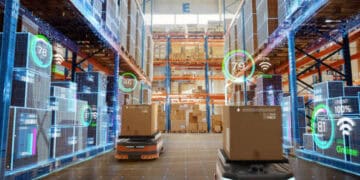A notable shift towards warehouse automation is underway, yet a considerable number of projects fall short of expectations.
As supply chain robots gain popularity, warehouse automation emerges from the periphery of the Fourth Industrial Revolution. With the automation market expanding rapidly, experts anticipate a surge in robot shipments, projected to increase by up to 50 percent annually through 2030, while warehouse automation is expected to grow by over 10 percent each year.
This growth comes as no surprise, given recent disruptions highlighting the pivotal role of robust supply chains. Companies now seek ways to enhance the speed, reliability, flexibility, and productivity of their warehouse and distribution operations, with automation positioned as a solution. It offers the promise of addressing labor challenges, improving fulfillment quality and safety, optimizing space utilization, and enhancing throughput.
Supply chain leaders are presented with a myriad of mature, capable automation solutions tailored to their specific needs. These include high-density storage and retrieval systems, goods-to-person robots, and collaborative robots (or “cobots”), some of which closely resemble humans, designed to work harmoniously alongside human employees. Automation providers have refined and diversified their offerings to cater to different demand scenarios, with advancements in technology further augmenting warehouse robots’ capabilities.
Despite these advancements, many automation projects fall short of expectations for several reasons. A lack of a cohesive vision, inadequate understanding of automation technology among leadership, and organizational misalignment are among the primary culprits. For instance, a consumer goods company invested over $150 million in consolidating multiple warehouses into a single automated facility, only to find its forecasts for inventory turns and shipment balance inaccurate, leading to underutilization of advanced automation features.
Developing a comprehensive warehouse automation strategy proves to be a complex task, with options ranging from point solutions addressing specific issues to the establishment of fully automated facilities. Decision-makers face a plethora of choices, each with varying benefits, costs, timelines, and risks.
To navigate this complexity and avoid common pitfalls, companies should adhere to seven best practices: clarify business needs, establish guiding principles for technology selection, evaluate diverse scenarios while allowing for future growth, adopt network-wide solutions over automation islands, create an efficient capital deployment strategy, develop and pilot a robust implementation plan, and prioritize employee skill development and organizational readiness.
For organizations considering warehouse automation, three immediate actions are recommended: formulate a comprehensive vision and strategy, educate board and leadership on available possibilities, and secure business-wide alignment on core beliefs and design principles.
Automation holds the potential to address warehousing and fulfillment challenges while facilitating long-term growth. However, success hinges on selecting adaptable solutions tailored to the company’s unique needs, providing a significant advantage over competitors.
Stay updated with supply chain news at The Supply Chain Report. Learn more about international trade at ADAMftd.com with free tools.
#WarehouseAutomation #SupplyChainRobots #FourthIndustrialRevolution #AutomationGrowth #WarehouseTechnology #SupplyChainOptimization #Cobots #CollaborativeRobots #AutomatedWarehouses #LogisticsInnovation #SupplyChainLeaders #WarehouseAutomationStrategy #SupplyChainResilience #RobotShipments #AutomationChallenges #SupplyChainSolutions #WarehouseRobots #AutomationTechnology #SupplyChainEfficiency #BusinessGrowth #WarehouseStrategy

















